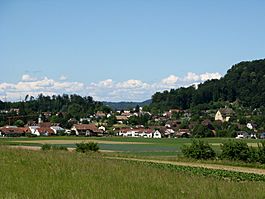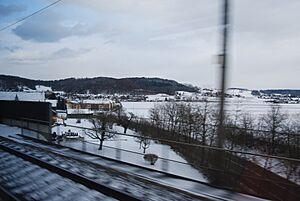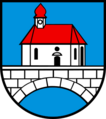Othmarsingen facts for kids
Quick facts for kids
Othmarsingen
|
||
|---|---|---|
 |
||
|
||
| Country | Switzerland | |
| Canton | Aargau | |
| District | Lenzburg | |
| Area | ||
| • Total | 4.72 km2 (1.82 sq mi) | |
| Elevation | 397 m (1,302 ft) | |
| Population
(Dec 2020 )
|
||
| • Total | 3,037 | |
| • Density | 643.4/km2 (1,666.5/sq mi) | |
| Postal code |
5504
|
|
| Surrounded by | Brunegg, Dottikon, Hägglingen, Hendschiken, Lenzburg, Mägenwil, Möriken-Wildegg | |
Othmarsingen is a village and a municipality in Switzerland. It is located in the Lenzburg district, which is part of the canton of Aargau.
Contents
A Look at Othmarsingen's Past
People have lived in the Othmarsingen area for a very long time. Scientists have found Stone Age tools made from special rocks. They also found ancient graves from the Hallstatt time, which was an important period in European history.
Othmarsingen was first mentioned in old writings around 1184-1190. Back then, it was called Otewizzingin. The village we know today grew from the original settlement and another village called Hüttwilen. Hüttwilen stopped being a separate village around 1504.
Who Ruled Othmarsingen?
In the Middle Ages, powerful families and groups controlled different parts of Switzerland. The Habsburgs, a very important family, held the highest power in Othmarsingen. After 1415, the city of Bern took over this power.
Local rules and decisions were made by different noble families. In 1484, Bern also gained control over these local matters. By 1539, Othmarsingen, along with nearby villages like Ammerswil and Brunegg, was managed by a local official called a bailiff.
Challenges and Changes
Othmarsingen faced tough times during the Peasants War of 1653. The village was badly damaged during this conflict. Local rules for the village were written down in 1680 and again in 1734.
Education started early in Othmarsingen. A teacher was working in the village by 1594. A private school has been open since 1657.
Religion and Churches
The village was split between two church areas, or parishes. The southern part belonged to Ammerswil parish, and the northern part to Staufberg parish. In 1528, the Protestant Reformation reached Othmarsingen from Bern. This was a big change in how people practiced Christianity.
A small church, or chapel, dedicated to Saint Mary was mentioned in 1371. This chapel was moved in 1593. A new church was built in 1675. In 1873, Othmarsingen finally became its own church parish.
Industry and Transport
In 1760, a factory that processed cotton opened in the village. Before World War I, there was also a factory that made products from straw.
Othmarsingen has always been well-connected by roads and railways. In 1770, a major road connecting Zurich and Bern was built through the village. Later, in 1877, the National Railway came through. In 1882, Othmarsingen was connected to the Aargau Southern Railway. A newer railway line, the Heitersberg railway line, was added in 1975.
Geography: Where is Othmarsingen?
Othmarsingen covers an area of about 4.73 square kilometers (about 1.8 square miles).
Land Use
- About 34.5% of the land is used for farming. This includes fields for growing crops and areas for animals to graze.
- Around 40.6% of the area is covered by forests.
- About 24.3% of the land is used for buildings and roads.
- A small part, 0.4%, is made up of rivers and streams.
The village of Othmarsingen is a "linear village." This means it stretches out along a road or river, rather than being built in a compact shape. It is located near the Bünz river.
Coat of Arms
The blazon (description) of Othmarsingen's official coat of arms is: "Blue, a Silver Church with a Red roof on a stone Bridge." This design shows a church and a bridge, which are important symbols for the village.
People of Othmarsingen
Othmarsingen has a population of about 2,233 people (as of December 2006). About 23.3% of the people living in Othmarsingen are from other countries.
Languages Spoken
Most people in Othmarsingen speak German, which is the main language. Italian is the second most common language, followed by Turkish.
Age Groups
Here's a look at the different age groups in Othmarsingen (as of 2008):
- Children (0-9 years old): About 9.4% of the population.
- Teenagers (10-19 years old): About 14.3% of the population.
- Young Adults (20-29 years old): About 12.1% of the population.
- Adults (30-59 years old): About 45.3% of the population.
- Seniors (60 years and older): About 18.9% of the population.
Homes and Households
In 2000, there were 840 private homes and apartments in Othmarsingen. On average, there were 2.5 people living in each home. About half of the homes were owned by the people living in them.
Population Changes Over Time
The population of Othmarsingen has changed over the years:
- 1764: 531 people
- 1850: 1,134 people
- 1900: 903 people
- 1950: 1,173 people
- 2000: 2,117 people
Important Buildings and Sites
The Reformed church in Othmarsingen is a very important building. It is listed as a Swiss heritage site of national significance. This means it is a special place that is protected because of its historical or cultural value.
Economy: How People Work
In 2007, the unemployment rate in Othmarsingen was 2.5%. This means a small number of people who wanted to work did not have a job.
Types of Jobs
People in Othmarsingen work in different types of jobs:
- Primary Sector: This includes jobs like farming. In 2005, 23 people worked in this sector.
- Secondary Sector: This includes jobs in factories and manufacturing. In 2005, 208 people worked in this sector.
- Tertiary Sector: This includes jobs in services, like shops, offices, and schools. In 2005, 508 people worked in this sector.
Many people who live in Othmarsingen travel to other towns for work. In 2000, about 78% of the working residents commuted outside the municipality. However, 510 people also came into Othmarsingen for work. Most people used a private car to get to work, while some used public transportation.
Religion in Othmarsingen
Based on the 2000 census:
- About 31.8% of the people were Roman Catholic.
- About 45.7% belonged to the Swiss Reformed Church.
- A very small number belonged to the Christian Catholic faith.
Education and Learning
Many adults in Othmarsingen have completed advanced education. About 72.1% of people aged 25-64 have finished either high school or higher education, like university.
Schools and Library
In the 2008/2009 school year, there were 179 students in primary school and 149 students in secondary school in Othmarsingen.
Othmarsingen also has a school and municipal library called Schul-u.Gde.Bibliothek Othmarsingen. In 2008, the library had over 5,800 books and other media. It loaned out more than 3,200 items that year.
Transportation
The Othmarsingen railway station is an important stop for the S-Bahn Zürich train system, specifically on the S3 line. This makes it easy for people to travel to and from Othmarsingen by train.
Images for kids
See also
 In Spanish: Othmarsingen para niños
In Spanish: Othmarsingen para niños








